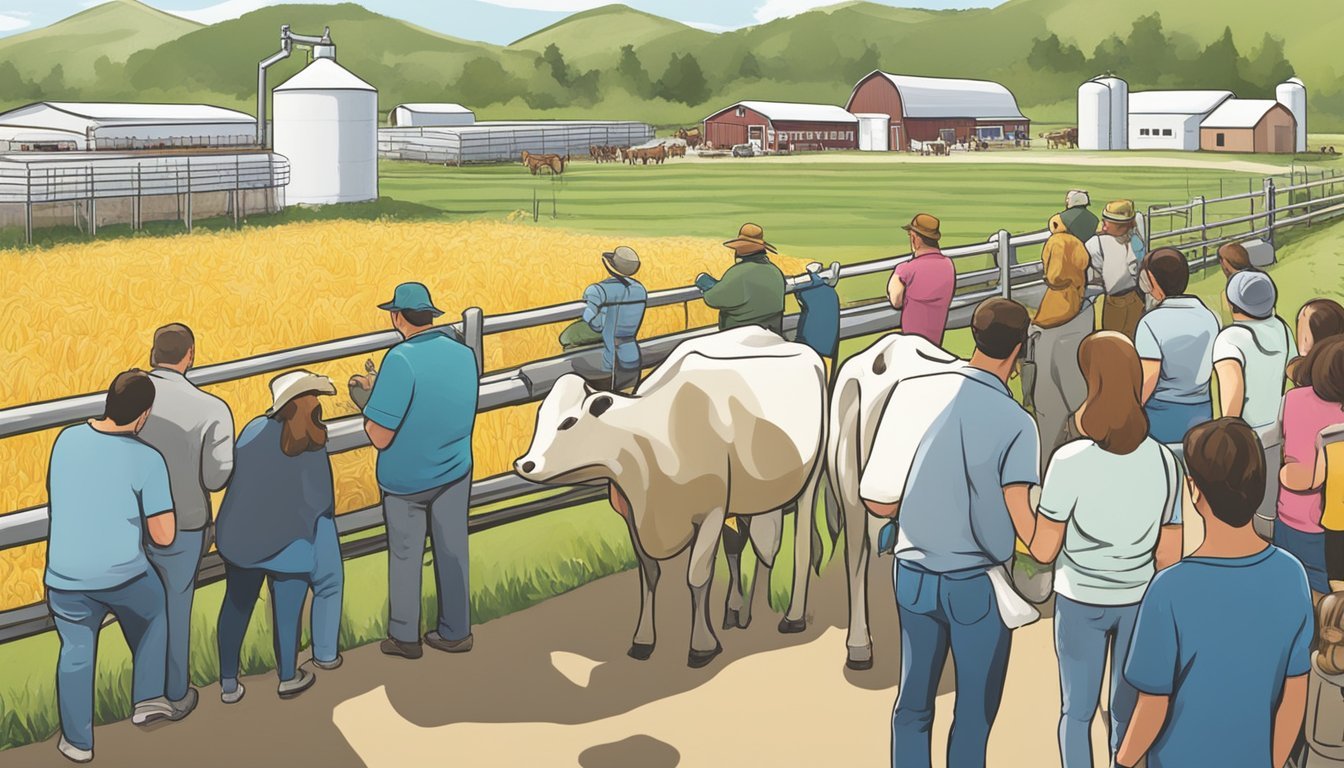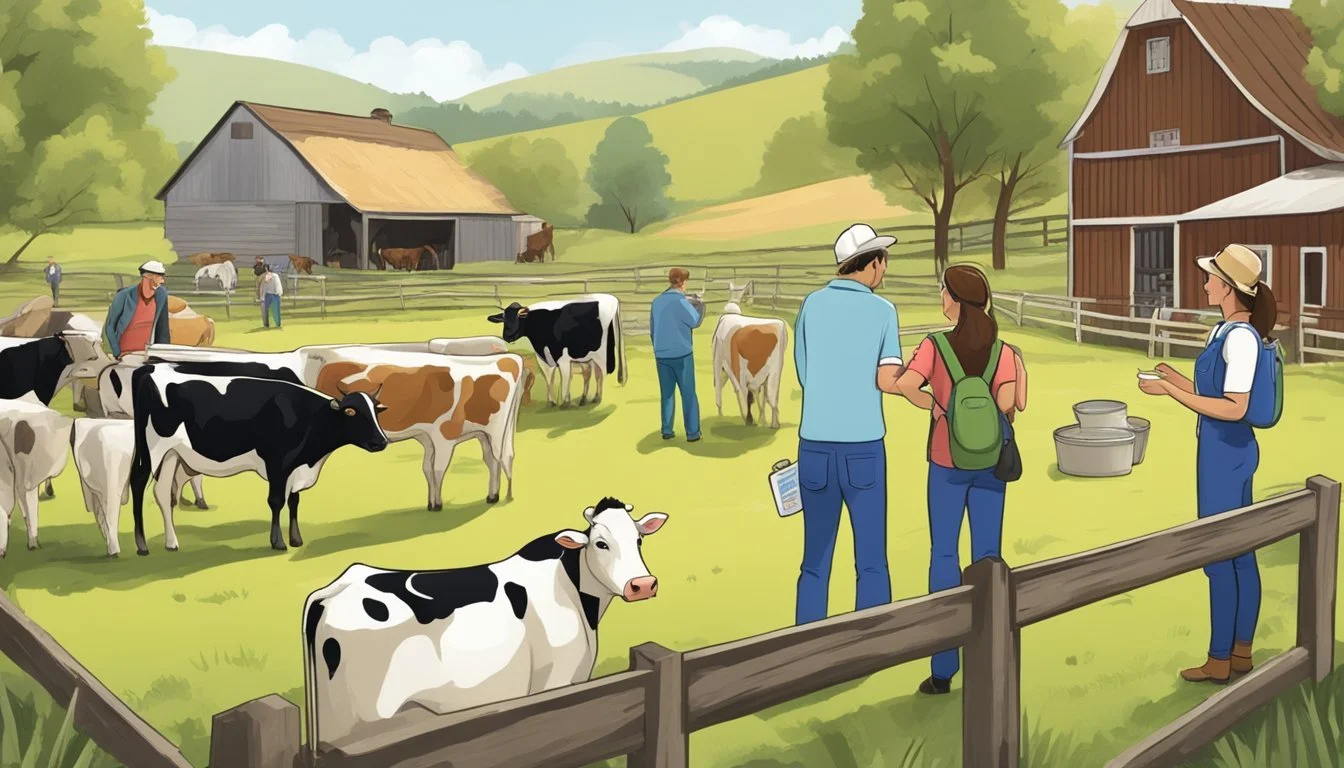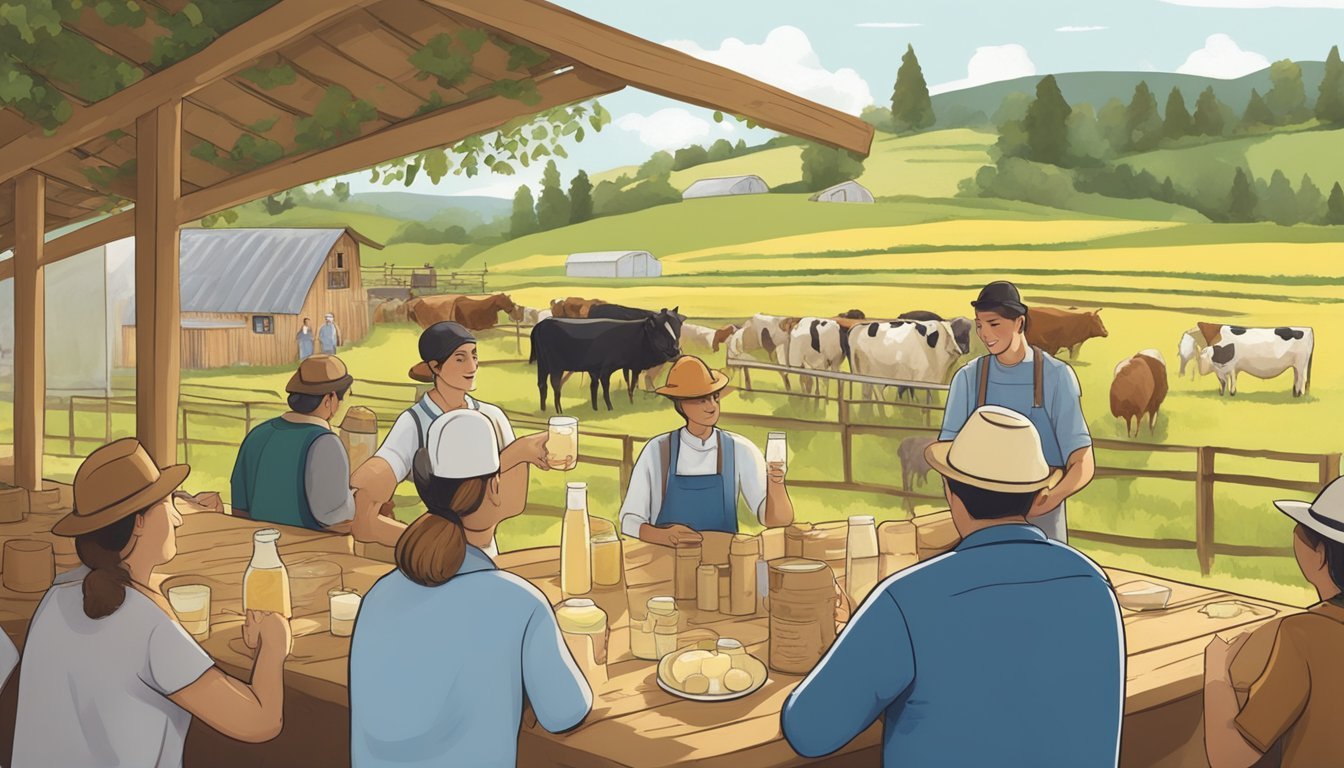Raw Milk Tourism
A Guide to Farm Visits and Tasting Experiences
Raw milk tourism offers a unique agri-tourism experience, inviting visitors to explore the origins of dairy production. This burgeoning trend combines the agricultural process of raw milk production with the leisurely enjoyment of tasting tours. Interested individuals or groups have the opportunity to set foot on serene dairy farms, where they can witness the daily operations and understand the meticulous care that goes into producing raw milk. These experiences often emphasize sustainable farming practices and the health of the dairy herds, ensuring that the cows graze on green pastures and thrive in healthy farm environments.
Visiting a raw milk farm can provide insight into the traditional and modern methods of dairy farming, ranging from the pastoral scenes of cattle grazing to the advanced processes within the creamery. A tour may highlight the route from cow to bottle, detailing how milk is produced and ultimately delivered fresh to the consumer. Tourists have the chance to observe the milking of cows, the functioning of the creamery, and the filling of milk into bottles. Some farms may even include interactive components, such as cow milking contests, to engage visitors in the process.
Raw milk tasting tours enhance the farm visit with the sensory experience of tasting dairy products in their most natural state. Farms offering these tours aim to connect consumers with their food sources and to share the quality difference that raw, unprocessed milk can provide. The overall experience is designed to be educational, transparent, and rich in tradition, presenting an authentic view into the world of dairy that many consumers are detached from. This approach not only fosters appreciation for the craftsmanship involved in dairy production but also ignites discussions about food sourcing and the benefits of supporting local farms.
Raw Milk Tourism offers an enriching and immersive experience, providing enthusiasts with the opportunity to delve into the captivating raw milk microbial world. This unique form of tourism allows visitors to gain insight into the diverse microorganisms present in raw milk and their role in the fermentation and maturation processes, fostering a deeper appreciation for the natural complexities of this wholesome product.
Moreover, Raw Milk Tourism serves as a platform for sharing and celebrating compelling raw milk consumption stories from individuals who have embraced raw milk as a source of nourishment and culinary delight. It provides a space for enthusiasts to connect, exchange experiences, and foster a sense of community around their shared passion for raw milk.
Ethical considerations are also central to Raw Milk Tourism, as it emphasizes the importance of sustainable farming practices, animal welfare, and responsible consumption, reflecting a commitment to raw milk ethics. Furthermore, it addresses the needs and preferences of an aging population, highlighting the potential benefits of raw milk as part of a balanced and wholesome raw milk diet.
In addition, Raw Milk Tourism offers educational opportunities for visitors to explore the role of raw milk in infant nutrition, providing valuable insights for parents and caregivers. Overall, Raw Milk Tourism provides a holistic and engaging experience, inviting participants to discover the multifaceted world of raw milk while fostering a deeper understanding of its microbial intricacies and cultural significance.
The Benefits of Raw Milk
Exploring raw milk involves delving into its nutritional value and distinct taste. This section will examine the specific advantages associated with raw milk, focusing on its nutritional components and the sensory experience it provides.
Nutritional Value of Raw Milk
Raw milk is a source of high-quality nutrition. It contains essential nutrients such as:
Proteins: Vital for muscle repair and growth, with approximately 8 grams per cup.
Fats: Provides energy and supports cell function, with around 8 grams per cup.
Calcium: Crucial for bone health, supplying about 30% of the Recommended Daily Allowance (RDA) per cup.
Vitamin A: An important antioxidant, offering around 6% of the RDA per cup.
These nutrients contribute to the overall dietary profile, making raw milk a nutrient-dense food choice.
Taste Profile of Raw Dairy Products
Raw milk aficionados often cite a richer, more complex flavor compared to pasteurized varieties. Dairy products such as cheese and ice cream made from raw milk carry this depth of flavor, allowing consumers to appreciate a broader taste spectrum that can be altered by pasteurization. It's these subtle taste nuances that draw people to raw milk dairy products.
Understanding the Risks
When visiting farms and engaging in raw milk tasting tours, it is crucial to be aware of the risks associated with raw milk consumption, including pathogen growth and legal implications.
Pathogen Growth and Raw Milk
Raw milk is milk from cows, goats, sheep, or other animals that has not undergone pasteurization—a process that kills harmful bacteria. Without pasteurization, raw milk can harbor dangerous microorganisms, such as Salmonella, E. coli, and Listeria. According to the Centers for Disease Control and Prevention (CDC), these pathogens can pose serious health risks, especially to the elderly, immunocompromised individuals, pregnant women, and young children. The Raw Milk Institute, while promoting the production of safe raw milk, acknowledges these risks and underscores the importance of strict farm management practices to minimize bacterial contamination.
Key Risks:
Bacterial infections from pathogens like Salmonella and E. coli
Severe health consequences for vulnerable demographics
Regulation and Legal Considerations
The legal status of raw milk varies by jurisdiction, influencing both farm operations and consumer access. In some regions, the sale of raw milk is permitted either directly to consumers at farms or through retail with clear labelling; however, in others, it's heavily regulated or completely banned to ensure public health and safety. Compliance with state and federal regulations is a must for raw milk producers, and failure to adhere can result in severe penalties. Visitors engaging in raw milk tourism should be aware of the legal context in the areas they are touring. Additionally, they should understand that while homogenization—a process separate from pasteurization—is not typically a legal concern, it affects the consistency and taste of milk, which is often part of the raw milk experience.
Regulatory Aspects to Consider:
Legality: Varies by region; ranges from allowed, conditionally allowed, to banned
Labelling: Required in areas where raw milk is sold legally
Raw Milk Institute: Advocacy and education on raw milk standards and practices
Please note that visiting farms and participating in raw milk tours necessitates a level of due diligence to ensure one's health and adherence to the law.
Choosing a Raw Milk Source
When selecting a raw milk source, consumers should prioritize endorsed suppliers and assess the producer's risk management approaches.
Raw Milk Institute and Endorsements
The Raw Milk Institute (RAWMI) plays a crucial role in ensuring the safety and quality of raw milk. They provide endorsements to farms that meet its strict standards, which involve regular testing and adherence to detailed management plans. These endorsements serve as a trustworthy indicator for consumers:
Listed Farms: Search for farms with a RAWMI listing, a sign that they maintain high safety standards.
Consumer Confidence: An endorsement from RAWMI reassures consumers about the quality of the milk they are purchasing.
Identifying Low-Risk Raw Milk Producers
Consumers must be able to recognize farmers who implement effective low-risk protocols for raw milk production. Key elements include:
Transparent Management Plan:
Farmers should have a clear and accessible plan detailing their milk production process.
Plans typically include hygiene protocols, animal health monitoring, and regular milk testing.
Farm Visitation:
Visiting a farm allows consumers to observe the animals' living conditions and the farm's cleanliness.
Personal experience aids in assessing whether a producer is low-risk or not.
By paying close attention to these factors, consumers can make informed decisions about sourcing raw milk from farms that prioritize safety and quality.
Farm Tours and Experiences
Farm tours provide an invaluable opportunity to gain insight into the agricultural processes behind dairy products. Visitors can expect an array of activities tailored to diverse interests, from observing the intricacies of a creamery to participating in hands-on tasks.
Variety of Farms and Tour Types
A plethora of farm tour options cater to various preferences, ranging from small-scale family-run ventures to larger, technologically advanced dairies. Visitors may choose a family outing for an educational yet leisurely experience or a class field trip that combines learning with fun. For those interested in witnessing the technical side of dairy production, a creamery tour reveals the journey from milking to bottling. Some tours capitalize on unique experiences such as the Moo-Mobile, allowing a close-up view of operations while aboard a farm-themed tour bus.
Family-Owned Farms: Expect a more personal touch, often with the chance to see calves and possibly a calf being born.
Larger Dairies: These may include modern facilities with automated tractors and machinery.
Interactive Farm Activities
Interactive activities on farm tours enrich the visitor experience significantly. They can participate in a cow milking contest, offering a playful challenge that also educates on traditional farming techniques. Furthermore, tours may schedule activities to coincide with daily farm chores, providing an authentic glimpse into the rhythm of farm life.
Milking Demonstrations: Engage in the milking process, often with an opportunity to try milking a cow.
Meet the Animals: Personal interaction with farm animals, such as feeding calves or observing their care routines.
By visiting farms and taking part in these tours, individuals not only learn about the origin of their dairy products but also gain an appreciation for the effort and care that goes into producing them.
State-Specific Destinations
Each region across the United States offers a unique raw milk tourism experience, ranging from the lush dairy farms of the Northeast to the comprehensive agritourism ventures in the sunny South. Highlighting state-specific destinations allows tourists to plan their visits to farms offering raw milk tastings and tours.
Northeast Agritourism: New York and Pennsylvania
In New York and Pennsylvania, visitors can explore a variety of dairy farms that showcase the region's rich tradition in milk production. New York, often celebrated for its artisan cheese, provides guided tours that allow visitors to witness the cheese-making process from farm-fresh milk. Similarly, Pennsylvania plays host to family-run farms that offer educational tours and opportunities to interact with the dairy cattle up close.
West Coast Dairy Farms: California and Washington
On the West Coast, California's vast agricultural landscape includes dairy farms where one can not only tour the facilities but also participate in cheese-tasting sessions featuring local specialties. Moving north to Washington State, tourists can join in on farm festivities such as the Lavender Festival at Purple Haze Lavender Farm, combining the experience of dairy with the region's distinct horticultural heritage.
Midwest Dairy Adventures: Wisconsin and Illinois
The Midwest is synonymous with dairy farming, and states like Wisconsin stand at the forefront of this tradition. In Wisconsin, dairy farms open their gates for visitors to sample world-renowned cheeses and view the milking process firsthand. Neighboring Illinois offers its own brand of dairy tourism, with farms that focus on educating visitors about sustainable dairy farming practices.
Southern Milk Trails: Texas and Florida
Down south, states like Texas and Florida offer diverse dairy experiences. Texas boasts large-scale dairy operations where one can learn about the industry's impact on regional economies. Meanwhile, Florida's agritourism includes not just dairy but also a diverse array of farm tours, which might include honey festivals and cattle ranches as seen in Northwest Florida's agritourism.
Dairy Education and Farm Life
In the realm of raw milk tourism, education serves as a cornerstone, acquainting visitors with the intricacies of dairy production and farm life. Participants gain first-hand knowledge of the journey from farm to table, understanding the dedication behind the products they consume.
The Process of Milking and Milk Production
Milking, the focal point of dairy production, is a process steeped in both tradition and technological advancement. Touring a dairy farm, visitors observe the milking process, which involves the following steps:
Preparation: Sanitation is paramount. Farmers ensure that the cows' udders are clean to maintain milk purity.
Milking: Specialized equipment gently extracts milk from the cows, providing a demonstration of efficiency and animal care.
Storage: The milk is promptly cooled to preserve freshness and prevent bacterial growth.
Bottling: In some farm tours, guests witness milk being poured into bottles, illustrating the final step before distribution.
This educational component brings clarity to milk production, revealing the effort behind every glass of milk enjoyed at home.
Understanding Dairy Farming and Animal Husbandry
An authentic farm experience delves into more than just milking; it encompasses comprehensive animal husbandry and the principles of farming. Key educational takeaways include:
Animal Care: Farmers share their knowledge on cows and calves, discussing nutrition, health, and genetics to ensure the well-being of the herd.
Farming Practices: Visitors learn about sustainable farming methods, crop management for feed, and the role of local agriculture in food systems.
Family Engagement: Many farms are family-run operations, where generations of knowledge shape their approach to farm life.
Educational Outreach: Programs offer live virtual tours and chats, enabling students and families to engage directly with farmers and ask questions.
Exploring dairy farms provides a comprehensive understanding of the dedication required to produce milk and fosters appreciation for the farmers' relentless pursuit of quality and care.
Product Tasting and Craftsmanship
Embarking on a raw milk tourism journey offers an immersive experience into dairy craftsmanship with an abundance of opportunities to sample exquisite dairy products, ranging from artisanal cheeses to fresh ice cream.
Sampling Dairy Delights: Cheese and Creamery Tour
Visitors are invited to indulge in a cheese and creamery tour, where they can taste the finest dairy creations straight from the source. Farms such as the widely recognized Sassy Cow Creamery provide guests with a sensory experience, allowing them to savor a rich assortment of dairy products.
Cheese Sampling: Gourmet cheese boards featuring options like raw milk cheddar and gouda.
Ice Cream Tasting: Homemade ice cream samples, celebrated for their creamy texture and pure flavors.
The Art of Cheese Making
The craftsmanship involved in cheese making is both an art and a science. Tour participants gain insight into the meticulous process of transforming raw milk into complex cheeses.
Milk Selection: The choice of raw milk is crucial, influencing the cheese's final taste, texture, and aroma.
Culturing and Curdling: Introducing beneficial bacteria and rennet to the milk begins the cheese-making process.
Aging: Time-honored aging techniques contribute to the depth of flavor in cheeses, resulting from careful maturation.
Direct-to-Consumer Sales
Direct-to-consumer sales enable consumers to purchase dairy products, including raw milk, straight from farm stores. This mode of purchasing ensures freshness and supports local farmers.
Benefits of Buying Direct from Farmers
Consumers who choose to buy directly from farmers enjoy fresher products and a closer connection to the source of their food. They benefit from transparency in production practices and can often observe the care given to cows which can result in healthier and high-quality dairy. Farms such as those in the Azores islands of Portugal, promote sustainable models that value animal wellbeing and ecological balance.
Transparency: Knowledge of animal care and sustainable practices.
Freshness: Dairy products sold immediately after production.
Farm Store Visits and Product Availability
Visiting farm stores is an authentic experience that allows consumers to see a variety of available dairy products including raw milk. Farms often set specific days and hours for visitors, such as the Poway Farmer's Market which operates on Saturdays. When visiting, guests can purchase raw milk, which is regulated and may vary in availability based on the region and the farm's production cycle.
Visit Hours: Farms like those advertising through "Get Raw Milk" provide structured visiting hours for consumers.
Product Range: Availability of raw cow milk, raw goat milk, etc., subject to regional regulations.
Innovations and Future of Raw Milk
Raw milk stands at the forefront of a dairy revolution, where innovations foster sustainability and quality. Technology and small-scale farming developments promise to redefine the industry's future.
Technological Advances in Dairy Farming
Advanced Data Analytics: The integration of data analytics in dairy farming allows for precise and informed decision-making. Farmers utilize technology to analyze everything from soil quality to animal health, leading to more effective management plans. This practice elevates the standard of raw milk production by ensuring optimal conditions for both livestock and milk quality.
Genetic Improvements: Selective breeding techniques, supported by genetic insights, enable the enhancement of dairy cattle's health and milk production efficiency. By focusing on genetics, farmers can work towards healthier cattle that produce high-quality raw milk with desirable characteristics.
Mentoring and Future of Small Scale Farming
Education and Mentoring Programs: An investment in education programs empowers small-scale farmers with the necessary knowledge to succeed. Through mentoring, experienced farmers pass on skills in sustainable farming practices and elaborate management plans that prioritize animal welfare and environmental health.
Sustainable Business Models: The growth of small-scale dairy production often correlates with increased profitability and community engagement. Farmers are adopting and mentoring others in sustainable models that not only support the ecosystem but also produce premium raw milk. These models are inherently transparent, connecting consumers with the source of their milk and fostering a deeper understanding of its production.
Through technology and mentoring, the raw milk industry is poised to thrive, prioritizing health, quality, and sustainability.





